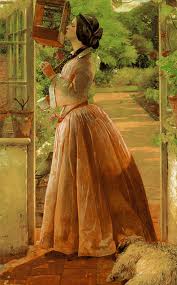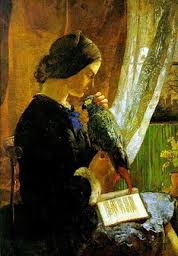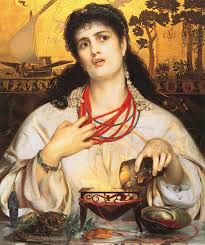Images of Femininity
by helen608
Pre Raphaelite women were depicted under the guise of many differentiating images of femininity, falling under the headings below. From saints to sinners, each depiction weighed heavily on symbolism to define its subject.
Holy Virgins
Often portrayed as Nuns in white habits, these women were pure of mind, body and soul. Rossetti said of his image of the virgin Mary, 1849, “The picture of mine was a symbol of female excellence – the virgin being taken as it’s highest type.” The use of sunshine and bright whites were employed to depict goodness, while lilys showed purity. In the image above, in which we see the angel Gabriel appearing to Mary with his message that she is to carry God’s child, the stem of the lily is directed towards her womb. The bare, tidy room symbolises spotless maidenhood and spiritual perfection. Despite the sexual connections of the implied conception, Mary’s body is modestly covered and her gaze and position suggest innocence and fear.
Nubile Maidens
These women were painted as younger females who are just blossoming into suitability for marriage. An awakening desire is depicted within their female form. In ‘The Bridemaid’ by Millais she wears the bridal insignia of orange blossom pinned to her dress, and is seen engaging in a Victorian marriage ritual of passing a morsel of wedding cake through a ring. These maidens are readying themselves for their husbands, epitomising budding sexuality, this is seen in particular in Rossetti’s pencil study where a long strand of hair is caught on the yearning, parted lips of his model.
Doves and Mothers
Once a woman is made a wife in Victorian society her duty is to be unwavering in her devotion to her husband and to bear his children. She is to be gentle, faithful and trusting. In both literature and art women were often referred to as birds, with their soft, fluttering hearts. This was also symbolic of keeping young women enclosed in their domestic lifestyle, as in Victorian times it was common to keep caged, exotic birds. An ideal wife was to exist with the timidity and obedience of a tamed animal. When Walter Deverell’s painting A Pet (seen above left) was first exhibited in 1853 it ran with the following text – “After all, it is a very questionable kindness to make a pet of a creature so essentially volatile.”
Fallen Magdalens
Far from the idealised dove like virgins, these fallen women were disreputable members of society – the seduced girls, adulteress wives, mistresses, courtesans and prostitutes. They stood for illicit sexuality, immorality and lust, a far cry from the high Victorian standards of dignity and restraint. In these paintings the figures were seen jeweled and alluring, shamelessly exhibiting their physical charms for the pleasures of men. Another version of this representation of women was a depiction of her seen in a state of penance with remorse for her sexual transgression. An example of this is seen in Sandy’s image of Mary Magdalene, above left. Her eyes are lowered in humility and she exudes a humble air.
Medieval Damsels
These paintings came from the time when masculine valour triumphed in literature, and women characters were simple, sweet and submissive. The stories revolved around feminine weakness, the women would rely on men to rescue them and protect them from danger. Their role was to be grateful for the bravery of the handsome male hero and to desire him completely, ready to throw themselves at his feet. They existed merely to flatter the attributes of the male characters.
Sorceresses
These depictions began when the idea of the femme fatale started to emerge in literature. The women were painted as paractitioners of evil magic, altogether amoral but with a divine sense of being. Despite the idea that these characters were wicked, they were never portrayed in a negative light, their seductive power and beauty were so strong that men found themselves falling under their spell. Rather than their womanhood ascribing them to be meager and passive, here it dictates their sensual, menacing mystery. Finally the female character is capable of holding some degree of power over the male – they are flirtatious enchantresses, using their sexuality to ensnare and enslave.
Ladies of death
Death was supposedly an appropriate end for rejected women in the art of the Victorian period. Men generally avoided romance with those who had been turned down, and in keeping with the ideal of everlasting love the women who had been were expected to stay faithful to the men who had not returned their love. The Pre Raphaelites were particularly fond of painting Shakespeare’s character of Ophelia as a representation of sorrowful, near pathetic death. Having found her love for Hamlet cruelly unrequited she becomes insane and ends up drowning in the river, her heart broken. The painting above by Rossetti is a tribute to his wife Lizzie after she had died. Originally Rossetti had broken off his engagement to her due to his deep passionate feelings for his lover – William Morris’s wife Jane. Yet when Lizzie appeared years later in seriously ill health he decided in guilt to marry her after all. After having a still born child she fell into depression and an addiction to opium. She died of an overdose in 1862, which was perhaps self inflicted. In the painting she appears as the character of Beata Beatrix, at the moment of her transition from earth to heaven, Rossetti has described it as “sudden spiritual transformation”. The bird drops a poppy, flower of death, into her hand.











